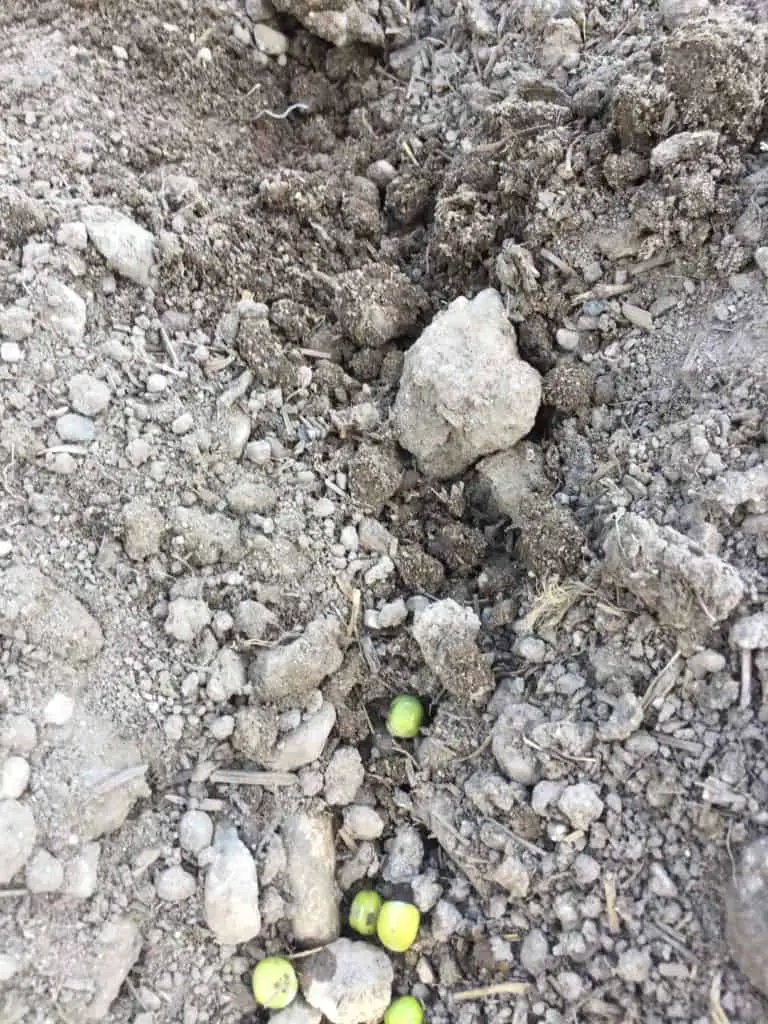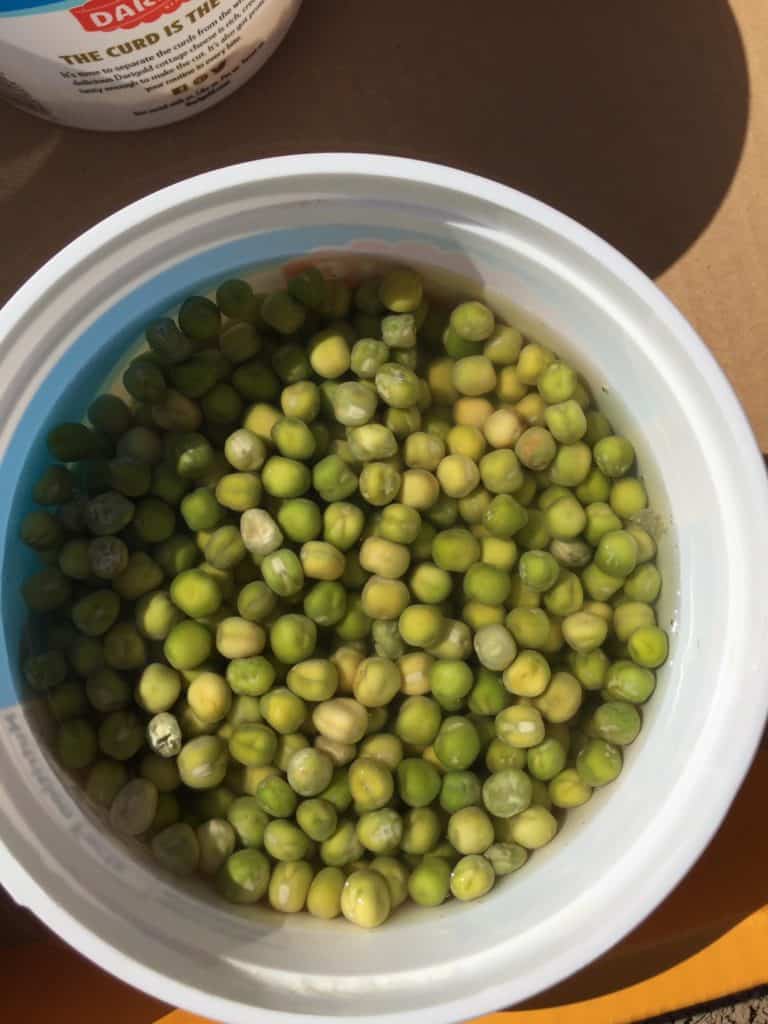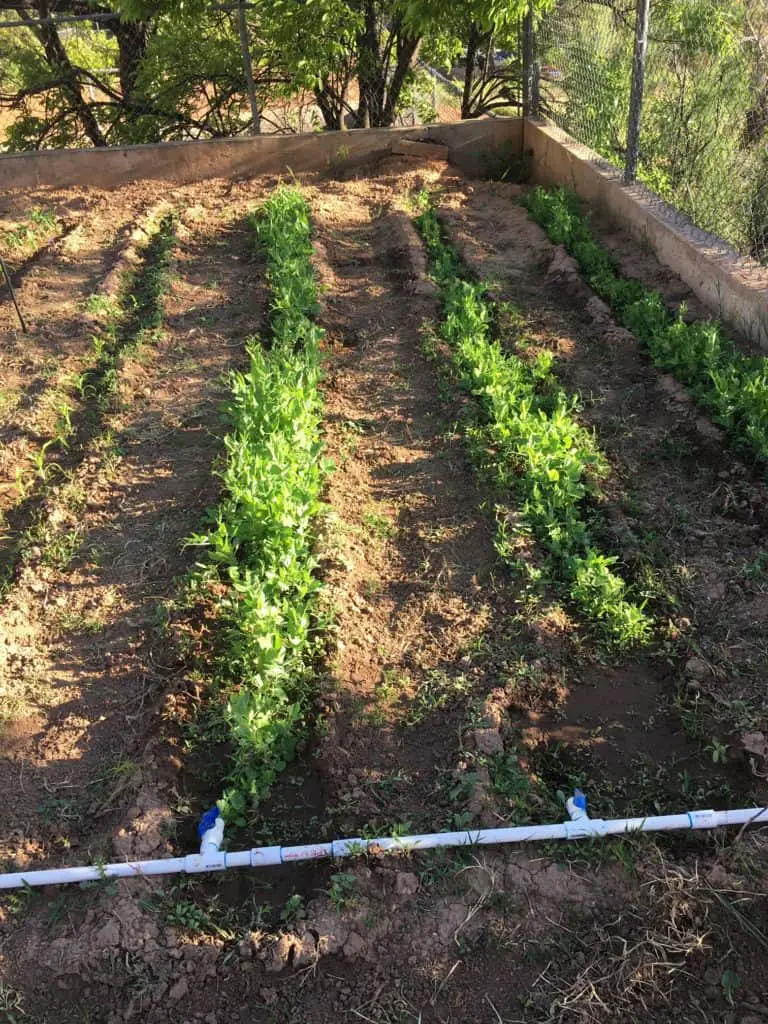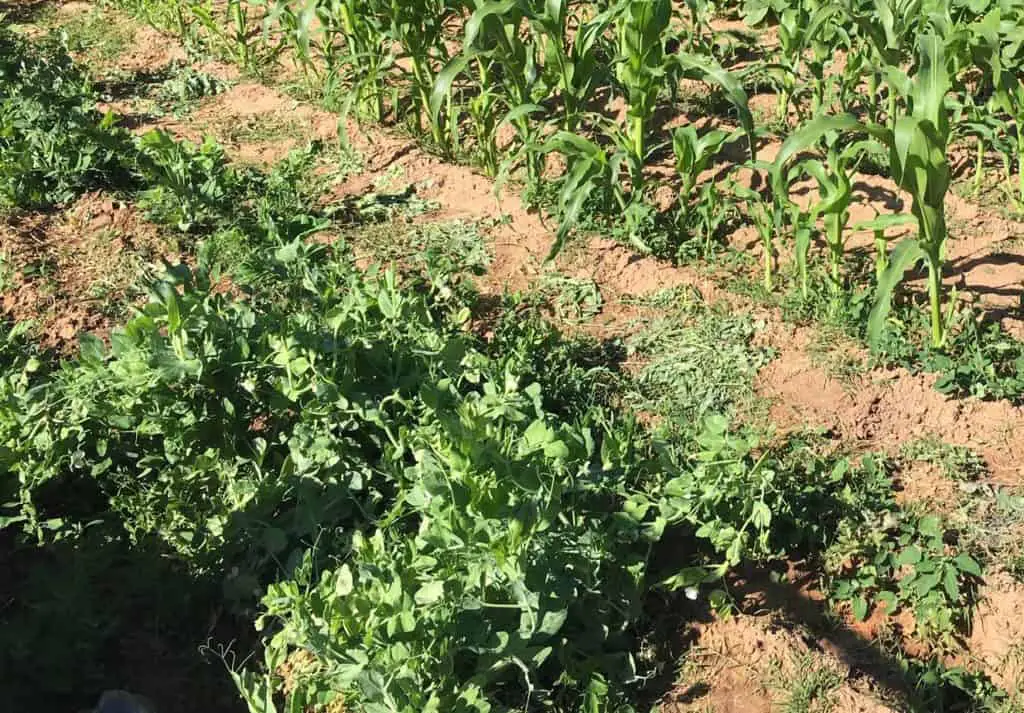Peas are a delightful sweet treat from the garden. Green peas can be cultivated and grown early in the growing season, and again in the fall when the temperatures grow cool.
In this article we will give you all the tips and a few tricks to ensure a great crop of peas. We will let you know about:
- The varieties of green peas you can plant, even some that can handle a little hotter temperature
- When and how to plant green peas
- Watering
- Fertilization
- Harvesting
- Preservation and storage
- Benefits
Some people will argue that the space required for growing peas is not proportional to the amount of product you get from them. I have been on this side of the argument many times. I find myself wondering if all the weeding, watering, picking, and shelling are worth the gallon or two of peas that we end up with.
I end up loving the flavor texture and satisfaction of the pea crop most every time. There is much more going on with the pea crop than meets the eye. We will discuss this in the benefits of peas a little later in the article. Let’s move forward and see what it takes to grow garden peas.
Varieties of peas
There are two main groups of peas, short determinate varieties, and tall indeterminate climbing varieties. Short varieties usually need no support and are simple to grow and provide excellent peas. When you grow the tall climbing varieties you will need to construct a trellis or have a fence or some kind of support for the peas to grow up on.
Short, Determinate
Some recommended short determinate varieties with great quality and yield are:
- Little Marvel
- Lincoln
- Green Arrow
Tall, indeterminate
There is one variety we would recommend for a tall indeterminate pea, Alderman peas. The Alderman variety has been a top choice of tall pea growers.
Warm temperature peas
Peas are a cold weather crop but there is a variety that can tolerate a little warmer temperature. Wando is a variety that you may want to try if you are planting a little late in the season, or you are in a warmer growing zone.
Edible pod peas, also called sugar, sugar snap, Chinese, and snow peas.
Some peas have been cultivated where the entire pod is edible. I was excited to grow these because what you picked is pretty much what you got. Picking and shelling peas leaves you with a pile of pea pods and a lot less volume of the peas themselves. It was encouraging for me to see the volume of the edible pod peas stayed the same for eating.
The varieties we recommend are:
- Dwarf Gray Sugar Peas
- Mammoth Melting Sugar Peas
- Super Sugar Snap Peas
Sugar Snap peas are relatively newly available for home gardeners. These are a pea that has been developed to grow full sized peas inside the pod and have less fiber in the pod. The result is a full round pea pod that you can eat the whole thing pod and all. I have gotten them in stores like Costco and the grocery market, but it is exciting to be able to grow some of these in the home garden or on the farm.
These edible pea pod peas are very popular. The older varieties had strings that grew on the top of the pod. You would have to process the peas by peeling off the string before eating them. There are newer varieties that are stringless. Look for the stringless seeds when getting your seed. Sometimes even the stringless varieties will develop strings when the weather is erratic and gets too cold or too hot when the pods are forming.
When and how do you plant peas?
Peas are a cool weather crop. You can plant them early in the spring, or in the fall when the temperatures cool down. Mild frost doesn’t hurt peas. Peas can even handle a light snow.
When peas are planted in the spring you can put the seeds in as soon as you can get onto the ground. Late winter and early spring will usually work fine.
An old timer around here would sew pea seeds in the late fall or early winter and have them germinate in the early spring when the ground warmed up. I am not certain how well this will work, but it might be worth a try.
The thing to remember is that green peas are a cool weather crop and will not do well when the temperature warms up and gets hot.
When you plant the pea seeds you should space them 2 inches apart. If you have sandy soil you will need to plant them 2 inched deep. If you have heavy clay soil you will need to plant them a little shallower, about 1 inch deep. The clay will keep more moisture in the soil and can sometimes create a harder crust for the pea sprout to break through.
Peas do well as a row crop and can be planted on both sides of a 30-36-inch (76-90 centimeters) row. You can also put them into a patch style planting, just keep them spaced far enough apart for the plants to fill out with leaves and peas.
We have used a manual seed planter to plant seeds and done well. Here’s one that works great.
You simply select the correct size planting disk, put the seed in the hopper on the top of the planter, set the depth on the foot of the planter and push it down the row.
If you have larger areas to plant you may, there are also some planters that you can attach to your garden tractor or ATV that you just pull.
When you are planting with a seed drill attached to a farm tractor, follow the specifications recommended by the manufacturer of your seed drill.

Planting tip
We have found that just opening up a row and placing the seeds by hand then closing up the row burying the seeds works great.
A tip that we use with peas is to soak the seeds in water for a few hours, sometimes even overnight to help with germination. When you soak the pea seeds, they will not work in the seeder, so planting them by hand is the best option if you soak the seeds in water.

Watering
When watering the peas, you will need to monitor them. Peas will need moist soil, but not too wet. Peas are highly susceptible to mildew. Due to the susceptibility of peas to mildew you should avoid overhead sprinkling. Peas to much better with furrow irrigation or a drip system.
Be observant if the soil is too dry. The peas will not develop the peas inside the pod well without good moisture. Sometimes a warm spell in the spring can dry out the soil pretty quickly.
Usually watering them once a week when it is cool and twice a week when the temperature warms up. This will depend on the composition of your soil, whether it is sandy or clay.
Fertilizing
Usually a light application of a general garden mix fertilizer will be plenty for peas. Here is an article we wrote about fertilizers that can help clarify.
Peas are a legume. They have the property of being a nitrogen fixer. They have properties with their growing that works to fix nitrogen into the soil. This leaves the soil full and ready for nitrogen using plants.
Often legumes such as peas are used as a green manure to help fertilize soil. We have a great article on it here. You can in effect use peas for a double purpose in your garden or farm.

Harvesting.
Harvesting peas is rather a simple technique. You grab the pod and grab the plant and carefully pull the pod off the plant. In my experience the peas don’t all ripen at once. It usually takes us 3-4 pickings to get all our peas. So being careful to not damage the plant is important. The final picking isn’t as crucial to save the plant, you can till it into the soil or remove it from the garden after the final picking.
Peas will ripen and begin to swell the pods. You will want to pick the peas when they are young and sweet, not old and hard.
When to pick the peas is always a conundrum. Some get a little too eager and anxious and pick too early. Younger peas taste better and picking the peas will stimulate the plants to continue bearing. Use your best judgment.
Snow peas and sugar snap peas also need to be picked when they are young and tender. If you wait too long the pods will grow fibrous and become pretty terrible to eat.
Shelling
With the exception of the Sugar Snap and Snow peas you will need to shell the peas out of the pod. This can be time consuming but is usually worth the monotony. The end results are sweet tasty peas ready to eat or store for future use.
Over the years there have been some interesting inventions to shell peas by machine. We have tried a few of these contraptions. Most of the time the peas end up turning into some kind of sad mush of pea juice and pulp.
The shells of the peas can be used for chicken feed, compost, or tilled back into the garden to add beneficial organic matter to the soil. The more organic matter that gets put back into the soil the better the loam of the soil will be. Here is an article on loamy soil we wrote.

Preserving and Storing Peas.
Peas are one of the first things to be harvested from the garden. They are sweet and full of flavor. You will probably want to eat them raw as a snack or blanched and devoured as soon as they hit the table. If you do end up having enough to store there are a few methods of storing and preserving peas for future use.
Canning Peas
You can preserve peas by canning them. For canning peas, you will need clean glass canning jars, canning lids, canning or pickling salt, water, and a canning pressure cooker. Here is a link to a canning pressure cooker, and here is a link to an instant pressure cooker that can be used for canning.
For a rule of thumb. 20 pounds of peas makes 9 pints. 31-1/2 pounds of peas makes 7 quarts. If you want to add salt to your peas it’s ½ teaspoon per pint, or 1 teaspoon per quart.
You will want to shell and wash the peas. You will then need to decide whether to can the peas in a hot pack or raw. Hot is when the peas are cooked before pressure canning. Raw is when you put raw peas into the jars and poor boiling water over the peas. Processing the jars in the pressure canner is the same for both methods. The difference will be the procedure and the taste is slightly different.
Hot pack
For hot pack peas cover peas in a large pot with boiling water. Boil the peas for 2 minutes to fully cook them. Add ½ teaspoon of salt per pint to the pint jars, or 1 teaspoon of salt per quart to the quart jars. The salt is added for flavor, you do not need to add the salt if you don’t want to.
Fill the jars loosely with hot peas. Add enough of the juice that the peas are cooked in to leave a 1-inch headspace in the top of the jar. Make sure the bubbles are out of the jars. If you are low on the juice the peas have been cooked in, you can just add boiling water to the jar until there is about 1 inch of space at the top of the jar.
Wipe the jar with a clean towel. Place the lid on the jar and screw the top or screw band on. Follow the recommendations on the lid package. You will need to tighten the screw band finger tight, meaning not too tight and not too loose.
Raw
The raw method is fairly simple. Fill the jars with raw peas leaving at least 1 inch of room at the top of the jar. Add boiling water to the jars leaving 1 inch of room, or headspace, at the top of the jar. Remove air bubbles in the jars. You may need to add a little more boiling water to the jars as you get the bubbles out.
Just like the hot pack, you wipe off the top of the jar with a clean wet towel, put on a lid and screw the top or screw band on. Make sure the screw band is finger tight, not to tight and not too loose.
Process Jars in Pressure Canner
Make sure you read and understand how to run and work the pressure cooker. Pressure cookers can be very dangerous and need to be used with great care. Read, follow, and be familiar with all guidelines from the manufacturer.
Prepare the canner by putting in hot water and the rack. Follow the recommendation of the manufacturer. If there are no specifications, then fill the canner two or three inches high with hot water. For hot packed peas you can preheat the water to 180 degrees F. When doing that you will need to make sure you don’t evaporate the water out of the pressure canner. For raw packed peas the water needs to be preheated to 140 degrees F.
A little timesaving tip is to prepare the jars while the water is heating in the pressure cooker. That way the jars and peas are hot when you can them.
Put the filled jars on the jar rack in the canner. Be careful to keep the jars upright. Sometimes tipping the jars can get food under the lid and will not let the jar lid seal properly.
Fasten the lid of the canner and turn up the heat of the stove. You will want to heat the water in the pressure cooker to a boil leaven the weight off the vent pipe or leave the petcock open. Steam will come out of the vent or the petcock. Let the steam go for 10 minutes.
After ten minutes of the steam flowing, place the counterweight or close the petcock. The pressure canner will pressurize in 3-10 minutes. The time it takes to pressurize depends on the elevation you are at. Refer to the manufacturer’s guidelines.
Make sure you keep a close eye on the pressure. If the pressure goes below the recommended amount you will need to bring it back up to pressure and start the time needed to process over. If you don’t, you risk the peas being under-processed and being unsafe to eat.
When finished processing take the canner off of the heat and let it cool. Just let it cool naturally to allow the proper processing of the peas. Forcing cooling could result in spoiled peas. So just relax and let it cool down by itself.
After the canner is cooled and depressurized take off the vent weight or open the petcock. Then wait another ten minutes and take the pressure canner lid off. Be careful not to mess up the lid and seal. Remove the jars one by one carefully. Let the jars cool naturally and sit for 12-24 hours.
Once cool you can eat the peas or store them on the shelf for future use.
Freezing peas
Freezing peas is one of the best ways of preserving peas to keep their texture and taste. Freezing peas is simple and straightforward. The process is blanching the peas, cooling them down quickly, putting them into containers, and then freezing them.
Shell the peas and wash them thoroughly. If you are freezing edible pod peas, just wash them thoroughly. Blanch them in vigorously boiling water.
You need to be aware of the elevation you are living at for how long to blanch peas. 1-1/2 minutes below 5,000 feet, and 2-1/2 minutes at 5,000 feet and above.
Cool the peas in ice water immediately after the time is up for blanching. The cooling process should take about the same amount of time as the blanching process. Drain them once cool.
You can then put them onto containers and put them onto the freezer. One thing you need to be cautious about. If the peas are left to freeze in a thick bunch or pile, they run the risk of getting spoiled or turning sour.
The best method we have found is to put a cup or two of peas into a freezer bag and spread the bag of peas flat in the freezer. This allows the peas to freeze quickly and uniformly.
Another method is to use a vacuum sealer. The process is the same as with the freezer bags, but you use the vacuum sealer to take out any air. Vacuum sealed food stays fresh tasting and will easily freeze. Here is a link to a vacuum sealer and the bags needed.
Drying Peas
Drying peas is very similar to freezing peas. You blanch them, cool them down, and put them in a dehydrator. You can use an oven, but a dehydrator is more efficient.
Shell and wash the peas. Bring a pot of water to a rolling boil. A precaution can be taken at this point. You can add 1 teaspoon of citric acid per gallon to the water. The citric acid acts as an anti-microbial agent.
Put the peas in about 4 cups to every gallon of boiling water. You will need to blanch the peas a little longer for drying. Below 5,000 feet 2-3 minutes, 5,000 feet and above 3-4 minutes. Put the peas immediately in ice water. Don’t cool the peas too much, just stop the cooking process. You will be heating them up with the dehydrating.
Drain the peas and dry them on a towel or cloth. Spread out the peas on drying trays in single layers.
Dry the peas in a dehydrator or oven at 140 degrees F. You may need to turn the peas over every 3-4 hours. As they peas get close to being dried, watch closely. They can sometimes get burnt or scorched towards the end of the drying process. Peas should be wrinkled, hard, and green when finished drying.
Most any dehydrator will work. Here is a link to a good dehydrator.
The time to dry peas in a dehydrator is 8-10 hours. A conventional oven will take a lot longer, up to twice as long.
After the peas are dried, they can be stored in a container with stay fresh packets, moisture-vapor-proof containers or bags.
Freeze Drying
Freeze drying peas has not been readily available for the home user. There is an option available for the home use now and can be used readily for most all vegetables and fruits including peas.
Freeze drying peas is very simple. You shell and wash the peas. Dry them out on a towel or cloth. You can also blanch them just as you would with freezing or drying peas.
Put the peas in the freeze dryer and let the freeze dryer go through its process. The freeze dryer can take anywhere from 30-40 hours to work depending on the moisture and size of the peas themselves.
Freeze drying tastes great and keeps the nutrients in the process. Freeze drying will keep the food edible for 25 years. The machine itself is a bit expensive. If you are planning to store a lot of your produce, then you will want to consider a freeze dryer.
Here is a link to a freeze dryer by Harvest Right. Give it a look, it could be a great tool for food preservation.
Benefits of growing green peas.
One obvious benefit of growing green peas is the great taste. Green peas are one of the earlier food you can get from your garden. Green peas are full of flavor, especially fresh picked.
Green peas are high in nutrients and low in calories. They have a good amount of protein for a crop grown in your garden. 1/2 cup of green peas provides:
- Calories: 62
- Carbs: 11 grams
- Fiber: 4 grams
- Protein: 4 grams
- Vitamin A: 34% of the RDI
- Vitamin K: 24% of the RDI
- Vitamin C: 13% of the RDI
- Thiamine: 15% of the RDI
- Folate: 12% of the RDI
- Manganese: 11% of the RDI
- Iron: 7% of the RDI
- Phosphorus: 6% of the RDI
Another great benefit of growing green peas is the nitrogen fixing properties. Peas will help fix nitrogen into the soil. This is a property of most legume plants. You will have better success in growing nitrogen using plants like corn, cabbage, and lettuce in an area where you have grown green peas.
If you can try to till the plant into the ground when it’s finished in the garden. The plant will break down well and add really beneficial organic matter. The addition of the organic matter really aids in soil loam and creates better soil for gardening.
Summary
Green peas are some of the earliest plants you can grow in your garden. Plant them in late winter-early spring. They grow well in cooler temperatures. Green peas are easily cultivated and provide a great tasting, nutritious treat. If grown and preserved well you can enjoy them throughout the year.

